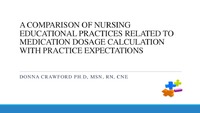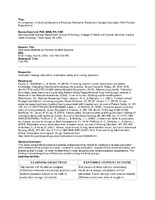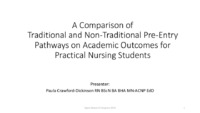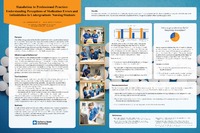| dc.contributor.author | Crawford, Donna | en |
| dc.date.accessioned | 2016-03-29T13:11:36Z | |
| dc.date.available | 2016-03-29T13:11:36Z | |
| dc.date.issued | 2016-03-29 | |
| dc.identifier | NERC16B02 | en |
| dc.identifier.uri | http://hdl.handle.net/10755/603873 | en |
| dc.description | <p>Nursing Education Research Conference Theme: Research as a Catalyst for Transformative Practice</p> | en |
| dc.description.abstract | <p>Session presented on Friday, April 8, 2016:</p>
<p>Accurate calculation of dosages and safe administration of medications in the clinical setting are essential skills for registered nurses (Coyne, Needham, & Rands, 2013; Jukes & Gilchrist, 2005; McMullan, Jones, & Lea, 2010). Nurse educators need to ensure that appropriate educational preparation is provided in order to ensure that student nurses become safe practitioners. The landmark study conducted by the Institute of Medicine of the National Academies (IOM; 2000) To Err is Human: Building a Safer Healthcare System brought to light the serious problem of medication errors. In the years following this publication medication errors continue to occur. In a 2007 report from the IOM, Preventing Medication Errors, it was estimated that between 380,000 and 450,000 preventable injuries occurred to patients in U.S. hospitals each year related to medication use, and on average, a hospital patient is subject to one administration error per day. In 2009, the FDA estimated that medication errors caused at least one death every day, and injured approximately 1.3 million people each year in the United States. James (2013) used data from 2008 to 2011 to estimate that the true number of premature deaths associated with preventable harm to hospitalized patients may be greater than 400,000 per year. Currently, in Indiana, medication errors continue to be the most common type of medical error in hospitals (Indiana Hospital Association, 2014). A medication error has the potential to cause patient injury, impact the reputation of the institution and the nurse who commits the error, and lead to psychological distress or loss of employment as a nurse (Schelbred & Nord, 2007). In 2003, Polifroni et al. reported the findings of a nationwide study which focused on the processes used to validate mathematical skills for medication administration. The results of this study indicated that both nursing students and nursing graduates have difficulty with basic mathematics skills and subsequently medication dosage calculation. Little consistency was found between teaching and testing processes among academic institutions or hospitals. The hospital nurse educators who responded to this study indicated great concern about the lack of ability of graduate nurses to perform dosage calculation prompting the authors to identify a need for a national conversation about educational practices related to dosage calculation in order to improve the abilities of students and practicing nurses with the goal of improving patient safety. In a subsequent publication, Polifroni, Allchin, and McNulty (2005) suggested three specific actions that were needed to address the problem of nurses' inability to meet hospital expectations in regard to medication dosage calculation: a) develop methods for improving communication between academic nursing programs and clinical nurse educators in order to align practices related to dosage calculation (for example, set passing scores and the use of calculators), b) provide frequent opportunities for the practice for this skill for both nursing students and practicing nurses, and c) create clear expectations for excellence in practice within healthcare settings and educational institutions. A decade later no evidence can be located in the nursing literature that indicates that these actions have been taken. This study compared educational practices and perspectives related to medication dosage calculation skills between three groups of nurses in Indiana -- academic nurse educators, hospital clinical nurse educators, and practicing staff nurses -- in order to determine if nurse educators are teaching to practice expectations. The findings indicated significant differences existed between practices and perspectives among the three groups. Three field-tested, content-validated internet questionnaires consisting of items with both open-ended and closed-ended questions were developed and distributed via email by three nursing organizations within Indiana. Items within the three questionnaires were analogous with only minor modifications based on the various employment roles of the target population; therefore, participants completed one of the three questionnaires. A total of 136 nurses responded, consisting of 68 academic nurse educators, 28 hospital clinical nurse educators, and 32 practicing staff nurses. Responses were analyzed using both descriptive and inferential statistics. Results showed that nurses in hospitals rated the ability to convert between different measurements as less important than academic educators. Significant differences were found between academic institutions and hospitals related to providing conversion factors during testing, the use of remediation, and perceptions about student abilities. Significant differences were also found between the skills that are taught in academic nursing programs, tested by hospital nurse educators, and used at the bedside by practicing nurses, except for the skill of determining an intravenous infusion rate in milliliters per hour. Most participants indicated that dosage calculation skills were important for safe medication administration. Implications for academic nurse educators include the need to deemphasize calculations requiring conversions. Implications for hospital nurse educators are that nurses rarely use some of these skills in practice and refresher courses may be required. An important implication for practicing nurses is the need to recognize recommendations by the ISMP and FDA and perform double checks of high-risk medications.</p> | en |
| dc.format | Text-based Document | en |
| dc.language.iso | en_US | en |
| dc.subject | Medication Dosage Calculation | en |
| dc.subject | Nursing Education | en |
| dc.subject | Medication Safety | en |
| dc.title | A comparison of nursing educational practices related to medication dosage calculation with practice expectations | en |
| dc.title.alternative | Alternative methods to promote student success [Session] | en |
| dc.type | Presentation | en |
| dc.rights.holder | <p>
All rights reserved by the author(s) and/or publisher(s) listed in this item record unless relinquished in whole or part by a rights notation or a Creative Commons License present in this item record.
</p><p>
All permission requests should be directed accordingly and not to the Sigma Repository.
</p><p>
All submitting authors or publishers have affirmed that when using material in their work where they do not own copyright, they have obtained permission of the copyright holder prior to submission and the rights holder has been acknowledged as necessary.
</p> | en |
| dc.description.note | <p>Items submitted to a conference/event were evaluated/peer-reviewed at the time of abstract submission to the event. No other peer-review was provided prior to submission to the Henderson Repository, unless otherwise noted.</p> | |
| dc.type.category | Full-text | en |
| dc.evidence.level | N/A | en |
| dc.research.approach | N/A | en |
| dc.contributor.department | Lambda Sigma | en |
| dc.author.details | Donna Crawford, RN, CNE | en |
| dc.conference.name | Nursing Education Research Conference 2016 | en |
| dc.conference.host | Sigma Theta Tau International | en |
| dc.conference.host | National League for Nursing | en |
| dc.conference.location | Washington, DC, USA | en |
| dc.date.conferenceyear | 2016 | |
| dc.contributor.affiliation | Indiana State University, Terre Haute, Indiana, USA | en |
| dc.description.reviewtype | Abstract Review Only: Reviewed by Event Host | en |
| dc.description.acquisition | Proxy-submission | en |






